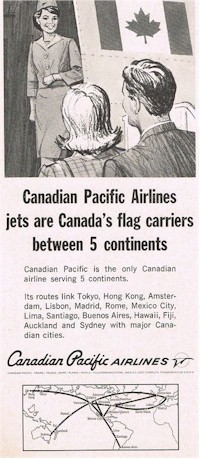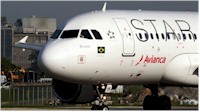|
Gretchen Aird Dawson sent in the following: Hi Terry, the "Silver Spitfire" flew into Kelowna this morning on it's around the world flight (never before attempted), which began in Goodwood, England. She's beautiful - looking like new with her very shiny Silver 'skin'. Thought you'd enjoy seeing these photos! Hubby Jim and I have just come home from seeing her fly into Kelowna for a day's visit. Dave McElroy (President of the Kelowna Flying Club), and former pilot was aware that "the 1943 Silver Spitfire" is on a round the world flight. Kelowna was not one of the tour stops; so Dave "flew down to Oregon a few days ago, and caught up with them and convinced them to add Kelowna as a tour stop. McElroy says: "Anyone who knows what the Spitfire is and what it did for the world in the Second World War, many would say the Spitfire changed history. So the opportunity to see one up close and personal and one that's flying around the world is a once in a lifetime opportunity." You can see from the photos below that it was a beautiful day to view the aircraft, and what a real thrill for all in attendance. |
|
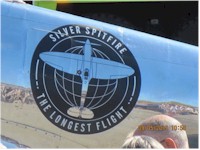 |
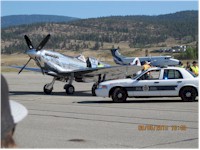 |
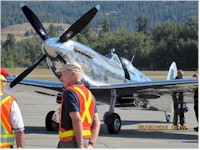 |
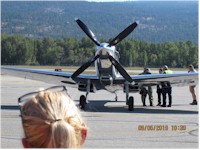 |
|
Ken Pickford has supplied the following additional information and links: Regarding the "Silver Spitfire" and its around the world trip. More on that aircraft in this article which also mentions its brief service with an RCAF squadron during WWII. Good photos arriving at Iqaluit (YFB) on August 12 and departing August 15. Iqaluit its first stop in Canada after Iceland and Greenland. It's accompanied by a chase plane carrying support staff and the second pilot (they alternate the flight sectors). It was delayed at Iqaluit for a couple of days due to weather and missed its planned appearance at an airshow in Gatineau, Quebec (across from Ottawa) where it was going to fly with the RAF Red Arrows (now on a month-long visit to North America) and two other Spitfires. It was previously painted in WWII RAF livery but they switched to bare metal, apparently to reduce potential problems with landing and overflight permissions etc., especially at the many planned stops in Russia, Asia, Middle East etc. Due to limited range it has to make many stops. Regards, Ken |
|
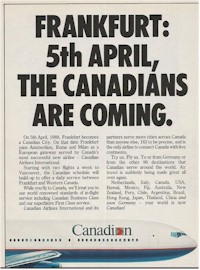 On April 5, 1988, Frankfurt becomes a Canadian city. On that date Frankfurt joins Amsterdam, Rome and Milan as a European gateway served by Canada's most successful new airline Canadian Airlines International. On April 5, 1988, Frankfurt becomes a Canadian city. On that date Frankfurt joins Amsterdam, Rome and Milan as a European gateway served by Canada's most successful new airline Canadian Airlines International.(Source: departedflights.com) |
|
Canadian Pacific Airlines jets are Canada's flag carriers between 5 continents. (Source: departedflights.com) |
|
There usually was a Fairchild 71 or an 82 any day around Edmonton from the late 1920's into the early 1960's. This lovely period view by Leslie features CPA's famous 82D c/n 69 CF-AXQ getting some daily servicing. Built in 1939 for Mackenzie Air Services of Edmonton, it migrated to CPA with that company's takeover in the early 1940's of a host of smaller northern operators. In 1946 CF-AXQ was acquired by Waite Fisheries of Ile-a-la-Crosse, Saskatchewan. When the pilot got into deteriorating weather on January 28, 1947 his windscreen iced up so badly that he couldn't see properly on landing, and crashed near home base. In our junior days of shooting at Malton in the 1950's we'd have been happy with the lighting here, but would likely have passed on even taking a shot for the record due to the gas drum, tie-down ropes, engine cover, open cockpit door ladder in the background and, horror of horrors, that fellow standing there. How pitiful, eh, to be missing out on such fundamentals of a true aviation scene. |
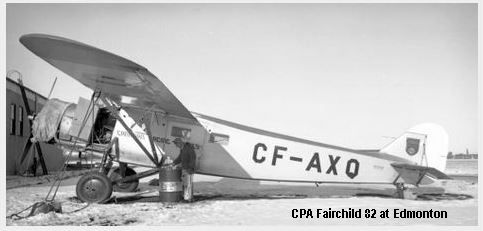 |
| CF-AXQ was sold to Wells Fisheries, Big River, Saskatchewan on December 3, 1946. The beloved “82” first had flown at Longueuil near Montreal on July 6, 1935. Twenty-four were built, including examples for Mexico and Argentina. (Source: From the Leslie Corness collection book via Larry Milberry/CANAV Books) |
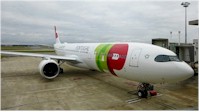 Star Alliance carrier TAP Air Portugal is suspending flights to London City Airport, blaming weaker-than-expected demand on the UK’s departure from the European Union (Brexit), as part of a wide-ranging network shakeup planned for 2020. Star Alliance carrier TAP Air Portugal is suspending flights to London City Airport, blaming weaker-than-expected demand on the UK’s departure from the European Union (Brexit), as part of a wide-ranging network shakeup planned for 2020.(Source: ATWDailyNews August 16, 2019) |
|
(Source: ATWDailyNews August 20, 2019) |
|
Kenneth Collie sends this personal memory of the BN2A-26 Islander - The picture of the Islander in Newsletter #1419 brought back fond memories of my decade old life in Northern Manitoba. I was working for Lambair in Thompson Manitoba when they imported what I believe to be the first Islander in Canada. BN2A-26 s/n 23, CF-XYK. My AME (Aircraft Maintenance Engineer) licence was so new I was afraid to fold it for fear that the ink would blot. The more senior engineers mostly looked after the Bristol Freighter or DC-3's. We all shared the DHC-2's and 3's Aztecs, Cessna's, and whatever showed up. But I considered Ex-ray Yankee Kilo to be mine. It was a nice plane to work on except for using a step ladder for everything on the power plants. We did have a few new plane design problems, the most noticeable was that as the temperature dropped to Manitoba winter minus 40's complaints of sloppy controls began to come in. I soon ran out of adjustment on the control cables so we contacted the Britten Norman Company. Within a week Mr Norman was visiting us in Thompson. After a bit of discussion and examination he was scratching his head with no solution in mind. Finally I asked him if there was a temperature compensator anywhere in the system. He asked, “why would you need a temperature compensator?” So I explained that each control cable was approximately forty feet long (he corrected me to the fraction of an inch) and these steel cables with a very low coefficient of expansion ran through forty some feet of aluminum (coerced to aluminium) with a relatively high coefficient rate therefore the tension was fine in hot weather but not at all fine in cold extremes. After looking at a couple other plane’s compensators he sat down and started calculating and drawing. I realized his genius when in less than half an hour he called his partner in England, faxed a drawing and the notes and said “Your modification will be mailed to you within three or four days. It was, it worked and he picked up the tab, the other tab also. The Islander proved to be a very nice plane to work on and to fly with. A little cold in the cabin in winter, but very reliable and quite efficient. Ken Collie |
|
|
Doug Davison has sent us this information – I joined 'Air Canada' (not TCA) on 5th May 1969. That was in PVM so they were already there. In fact, I must have had an interview in March or April so 3rd July 1969 for their move into PVM doesn't sound right. I remember the big snow storm. I was at home and stayed there! I lived in an apartment near the Vertu station at the time. Some weeks ago you had a piece on Air Transit. I was digitizing some old slides and I came across Air Transit photos. I was involved in the market research prior to the operation starting up. I got a ride - the only passenger - from Montreal to Ottawa on a test flight. In Ottawa, the aircraft stopped and I got out. The pilots did a couple of circuits while I stood on the grass at the edge of the runway and took 8 mm movie (which I still have somewhere) .....'elf and safety where are you? They stopped again, I got back on and we headed home to Montreal. I can tell you exactly when that was, a famous day in Canadian history: 28th September 1972. |
|
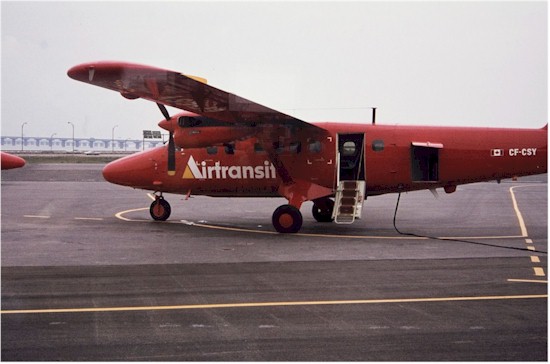 |
|
 |
|
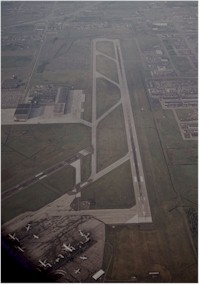 |
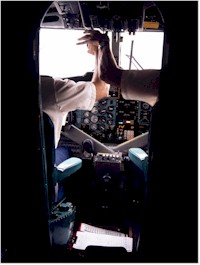 |
|
Lauraine Pomerleau comments on the WACA trip to Israel from NetLetter #1419 I just read the Netletter and couldn't help but notice the WACA Israel trip advertised. Doreen Zenert and I are retired AC flight attendants and did this tour with WACA in February and it was fantastic. It was a beautiful country and excellent tour for Interliners. If anyone has questions about it you may contact me at |
|
|
Michel LeBlanc adds this recollection from the March 1971 snow storm from NetLetter # 1420 I just finished reading your always interesting NetLetter. How it manages to bring back memories is par for the course but the recollection of the March 1971 massive snowstorm in Montreal was still particularly vivid for me. Although everything did grind to a halt and Skidoos were the only things moving on the streets, the measured snow fall was nowhere near 147.7 inches. Maybe 47 would be closer to the total for that storm. Best regards Michel LeBlanc |
|
|
Ken Pickford has been doing some fact checking: Re the Michel LeBlanc feedback re the snowstorm. 47 inches looks like the correct number, not 147. That would have been really something, over 12 feet! Found this CBC item: www.cbc.ca/news/canada/montreal/storm-of-the-century By the way, I also had an email from a retired AC colleague I dealt with during my IATA days. He points out that the reference in the TCA/AC People Gallery to TCA moving into Place Ville-Marie in July 1969 is wrong; it was July 1962. Of course, by 1969 it would have been Air Canada, not TCA. PVM opened in 1962 and TCA was one of the original tenants as I recall. His message quoted here, quoting NetLetter #1383: Hi Ken, Just read the above which states TCA’s move date to PVM as July 3, 1969 which is incorrect. The correct date is July 1962 as stated previously in NetLetter #1383 dated Jan. 31, 2018. I joined in January' 64 in PVM. “On July 3, 1962, in Montreal, TCA/Air Canada moved its headquarters from the Aviation Building across the street to the newly opened Place Ville Marie aka PVM. It not only became Montreal's tallest structure at the time, but also heralded, with its underground complex, an entirely new era of modern urban living, to be copied throughout the world." |
|



